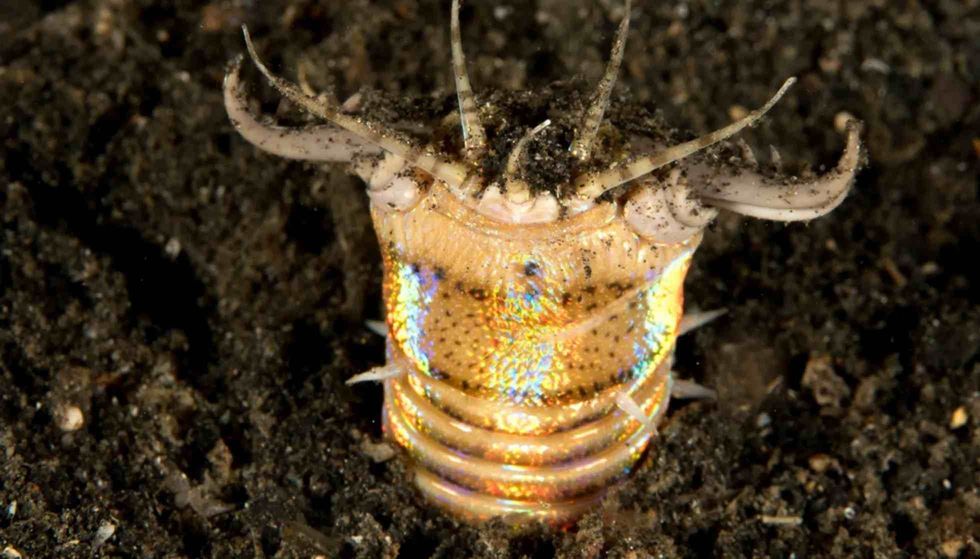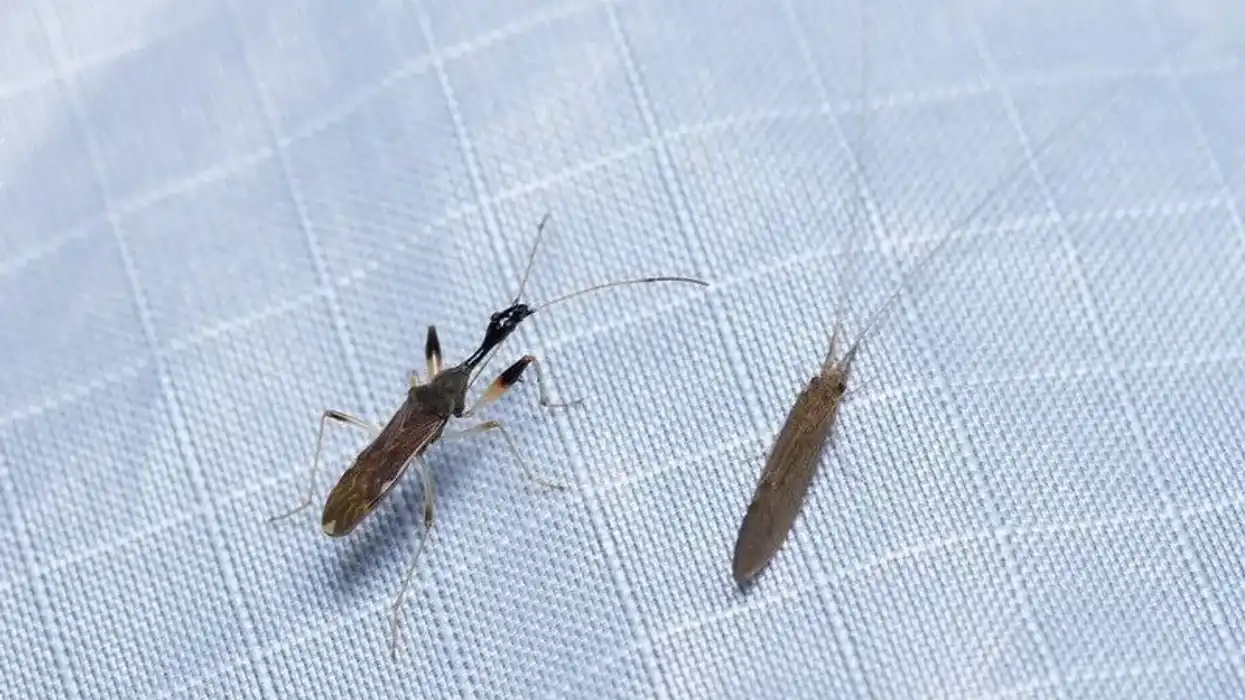The bobbit worm (Eunice aphroditois) is a type of benthic bristle worm that lives in the warm marine waters of the Atlantic Ocean. Populations of this worm have also been reported in the Indo-Pacific and in other ocean and sea environments on our beloved blue planet.
It's one of the most well-known Polychaetes, and this Polychaete worm is known for its hard exoskeleton which displays a wide range of black and purple colors and bristles.
The bobbit worm (Eunice aphroditois) is one of the most notorious ambush predators in marine environments. As an ambush predator, it burrows its entire body in the ocean or sea floor's soft sediment. It has antennae that help it to detect prey, following which it attacks the prey using its mouthparts which are known for being incredibly sharp.
In this Kidadl article, we'll take you through all the astounding true facts about the bobbit worm. So if you're interested in marine life, read on to know more about bobbit worm size, bobbit worm length, and more bobbit worm true facts. For more facts-based articles right here on Kidadl, check out the Christmas tree worm and sea slug.
Bobbit Worm Interesting Facts
What type of animal is a bobbit worm?
The bobbit worm, as the name suggests, is a type of worm.
What class of animal does a bobbit worm belong to?
The bobbit worm belongs to the class of animals known as Polychaetes.
How many bobbit worms are there in the world?
The exact population of bobbit worms is unknown. However, according to estimates, the population of this species thrives in the warm waters of the Indo-Pacific and the Atlantic Ocean.
Where does a bobbit worm live?
Bobbit worms live in the warm waters of oceans such as the Atlantic and the Indo-Pacific.
What is a bobbit worm's habitat?
The bobbit worm is a species that is found prowling in marine environments that are habitats of its prey. For example, populations of bobbit worms thrive in coral reefs which are full of their prey.
The coloration of coral reefs also contributes to its high population as it allows the bobbit worm to blend in with the environment. Coral reefs also offer limited and tight spaces for the bobbit worm which it uses to its advantage thanks to its slim body.
Apart from coral reefs, bobbit worms also inhabit other habitats such as muddy and sandy sediments, commonly found around sponges and rocks. Populations have also been reported at depths of 311 ft (95 m) underwater.
Who does the bobbit worm live with?
This Polychaete worm tends to live on its own.
How long does a bobbit worm live?
While information regarding the lifespan of bobbit worms is scarce, experts believe that most bobbit worms live for three to five years.
How do they reproduce?
Bobbit worms reproduce asexually. Marine biologists have observed these worms in captivity and according to their observations, bobbit worms reproduce by splitting apart into different pieces.
While the tail section that splits off ends up dying, the remaining pieces regenerate and grow into fully-formed bobbit worms. It's this exceptional reproductive ability that makes the bobbit worm able to create 'clones' of itself.
It also renders them capable of regenerating themselves even after they have been hunted by predators in the wild. More scientific research is underway to pinpoint the exact genetic mechanism that causes bobbit worms to reproduce the way they do.
What is their conservation status?
As not much is known regarding the bobbit worm's population distribution around the world, there is no specific conservation status that has been attributed to this species. It has a status of Not Evaluated.
Bobbit Worm Fun Facts
What does the bobbit worm look like?
Bobbit worms do not have eyes. Their sensory perceptions are purely dependent on their antennae and bristles which they employ to detect danger in the wild, along with prey.
The antennae are located on the worm's head. The body of a bobbit worm consists of an extremely hard exoskeleton.
The bobbit worm's main weapons in the wild are its retractable mandibles which the worm uses to strike and stun prey. Certain prey may even be snapped into two pieces, such is the power of the mandibles. The bobbit worm's exoskeleton may display one or more colors, with deep purple and black being the most common colors.
Metallic colors may also be observed in some bobbit worms. While most bobbit worms range between 2-4 ft (61-121 cm) in length, longer worms have also been sighted with the longest bobbit worm almost being 10 ft (3 m) long.
However, irrespective of their varying lengths, they are not very heavy. Most of them are quite slim which allows them to hunt in the tightest of marine environments.

How cute are they?
If you have a natural liking for worms, you may find the bobbit worm quite interesting in terms of appearance. However, using the word cute isn't really appropriate for the bobbit worm. The only cute thing about this worm is its name.
How do they communicate?
Very little is known about how bobbit worms communicate with each other and other creatures in the wild. As a lot of research is underway to understand more about this species, we can expect science to shed more light on this subject in the years to come.
How big is a bobbit worm?
Compared to the largest earthworms, which are typically just over 1 ft (0.3 m) in length, the bobbit worms are at least two times bigger.
How fast can a bobbit worm fly?
Bobbit worms cannot fly. They swim underwater to go from one place to another. However, their exact speeds underwater are not known.
How much does a bobbit worm weigh?
On average, bobbit worms weigh around 1 lb (0.45 kg). However, the biggest bobbit worms may be heavier than that.
What are the male and female names of the species?
The bobbit worm does not have any gender and that is why they haven't been given any gender-specific names.
What would you call a baby bobbit worm?
There are no specific names that are used to refer to baby bobbit worms. If you plan to adopt a baby bobbit worm as a pet, feel free to name it anything!
What do they eat?
Before we get to what bobbit worms eat, let's take a look at how they capture their prey. As mentioned before, a bobbit worm relies on its five antennae to detect stimulus from prey in its vicinity.
Once its antennae detect prey, the bobbit worm ambushes its prey and latches on to them. Despite their slim and slender profile, they are quite powerful underwater and they drag their prey down under the substrate.
It then uses its retractable mandibles to perform the iconic bobbit worm bite, following which it eats and digests the prey. Most bobbit worms eat worms and small fish, along with macroalgae, seaweed, and detritus.
Are they dangerous?
Bobbit worms are known to be extremely dangerous predators in their natural marine environments. However, thankfully, they aren't dangerous towards humans at all, despite some opinions that claim contrary views.
The fact of the matter is that while the mandibles on a bobbit worm's body are quite powerful which makes it a very capable predator, they are not strong enough to penetrate human bones which are significantly stronger than the bodies of the fish and worms that bobbit worms eat.
Would they make a good pet?
The answer to this question depends purely on whether or not you view worms as pets. Adopting a bobbit worm as a pet is uncommon.
However, some people have been known to do it. Remember, if you keep a bobbit worm at home, you will have to spend money on an aquarium and also ensure that inside the aquarium, the environment resembles its natural environment in the wild.
You'll also have to arrange for the regular feeding of the worm. While you can definitely keep a bobbit worm as a pet if you are committed to it, we recommend letting the bobbit worm be in its natural environment.
Did you know...
Bobbit worms are relatives of the fireworm, another Oolychaete. The only significant difference between bobbit worms and fireworms is that the retractable mandibles are used by fireworms defensively only, whereas bobbit worms use theirs in an offensive manner. Check out some other worms such as the anchor worm, tube worm, and earthworm.
How did the bobbit worm get its name?
Dr. Terry Gosliner came up with the name bobbit worm in his book titled 'Coral Reef Animals Of The Indo-Pacific' which was published in 1996.
How do you get rid of bobbit worms?
If you're terrified of worms in general and your aquarium at home is invaded by a bobbit worm, it's best to use bait to lure it out of the aquarium and then finally out of your home.
We recommend not trying to destroy it by cutting it into separate pieces, because as we mentioned before, bobbit worms are a species that can regenerate into fully-formed beings from separate parts.
Here at Kidadl, we have carefully created lots of interesting family-friendly animal facts for everyone to discover! Learn more about some other insects from our velvet worm facts and desert Tarantula facts pages.
You can even occupy yourself at home by coloring in one of our free printable bobbit worm coloring pages.










